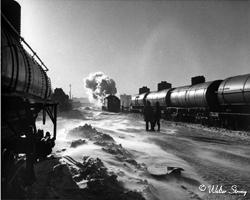 |
1. Anchorage is in the back ground of this
photo taken looking nearly due South on a brisk early spring day near the
Old Army POL farm. Standard Oil/Chevron loading racks are behind the photographer
. The crew is standing in the middle of what is now the main road to the
Anchorage dock about where the guard house is located. The loaded tank
cars would have originated in Whittier. |
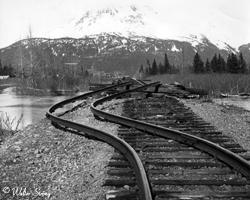 |
2. Road bed and rail damage
at Portage following the March 27 1964 earthquake. Surround terrain had
sunk as shown here by the water incursion from Turnagain arm off to the
left of this photo. |
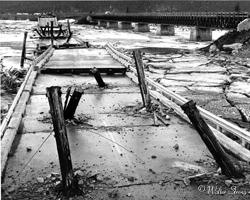 |
3. The Twenty Mile River
Highway bridge following the March 27 1964 earthquake. The steel pile had
concrete
caps below the concrete deck. The caps were sheared of the piles and then
the piles drove through the deck as the bridge collapsed. The railroad
bridge just up river in the photo survived and was back in operation soon. |
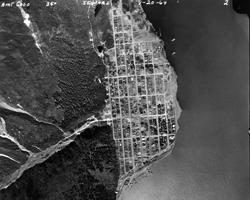 |
4. Post earthquake photo
dated 7-20-64. Seward main streets run due North from the docks at the
bottom of the picture where the railroad terminated. The entire railroad
yard and docks that were at the Eastern edge of town along the waterfront
are now gone. |
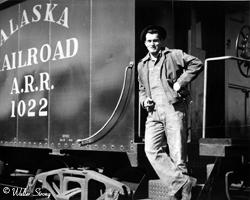 |
5. Walter Strong on new caboose
#1022. |
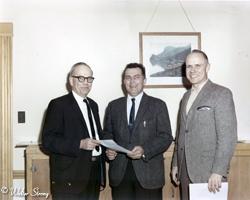 |
6. (left to right) Assistant
General Manager Dick Bruce, Trainmaster Walt Strong, Superintendent of
Transportation Bill Davidson |
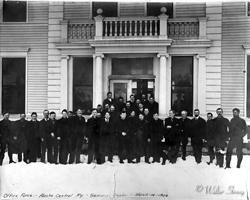 |
7. From the caption: Office
Force,- Alaska Central Ry.-Seward, Alaska. - March 10, 1906. My guess this
is the entire railroad staff and a few customers as well. At that time
the Alaska Central Railroad went to mile 50 and connected to nothing in
the middle of the winter. This is probably a spring organizing meeting
planning for the summer season construction. Head hunters were busy convincing
their key employees such as John Van Cleve,(5th from the right) Master
Mechanic and Superintendent of Motive Power, to move to Eyak and work for
Heney and Hawkins to build the Copper River and Northwestern. |
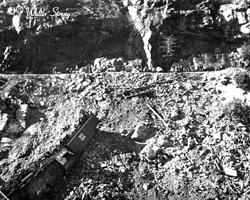 |
8. This scene is not on the
Alaska Railroad |
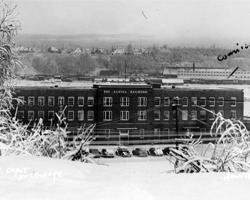 |
9. Alaska Railroad Depot
and General Office on Ship Creek in Anchorage shortly after completion
in September 1942. There were later addition to both ends of the building.
The notation Commissary refers to the large white building on the other
side
of ship creek. |
 |
10. Roster photo of 4-8-2
Light Mountain #801 on the Anchorage Turntable. |
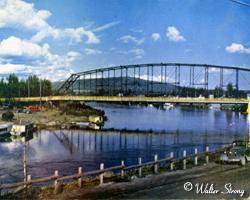 |
11. Cushman Street Bridge
in Fairbanks looking up river. The ARR end of track is about one city block
to the left of this image at the station. |
 |
12. Locomotive #702 at the
Healy Yard. In this photo she still had the standard cab and the booster
on the trailing truck. Both features were changed in later years. |
 |
13. Looking down the Nenana
River overlooking the original five span deck bridge on the Suntrana spur.
The Suntrana coal tipple is about 2 miles to the right and the Healy yard
is on the bluff to the left of this image. This bridge was later replaced
with a thru span moved from another location. Today the mine mouth Healy
Power Plant is just to the right of the photo and the White Elephant fluid
bed clean coal plant is in moth balls just right on the shore downstream. |
 |
14. What can I say. "Shist
happens" Just another rock slide probably in the Healy Canyon. |
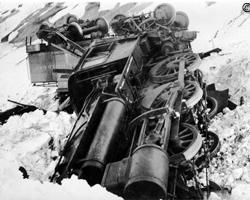 |
15. 16, 17, 18. What can
I say. "Snow happens". Correct me if my eyes deceive, but I do
believe this is Mogul #611 showing us her belly after either being caught
in or running up on a snow slide along Turnagain Arm. Best guess would
be around Bird Point. These are some of the best detail shots you will
find of the 600 class Panama Moguls. Compare the width of the tender tires
to those on the locomotive. She had wide tires to the inside to reduce
her gauge from 5 ft to 56 1/2 inches. This also made these locos subject
to hard rides on ice because they would run up on ice outside the rails
that other traffic failed to remove. |
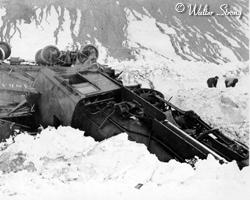 |
16. See description #15 |
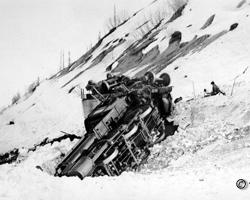 |
17. See description #15 |
 |
18. See description #15 |
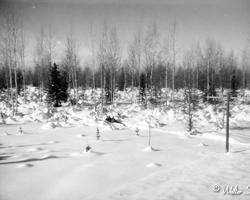 |
19. and 20. Please not another
moose photo. These are instructive, as the first one is either laying down
or wading in deep snow. The later view is headed railroad North past Peters
Creek along Knik Arm. Those are the Talkeetna Mountain due North. |
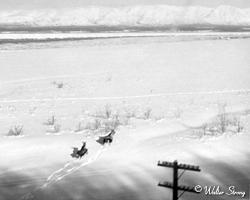 |
20. See description #19 |
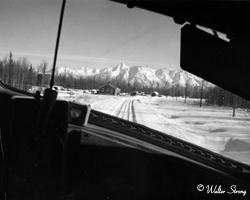 |
21. In the cab of a new EMD
F7 approaching the Eklutna Section house. Lazy Mountain is in the background. |
 |
22. Conductor taking it
easy. This could be the Seward with its large rear facing window and
offset door on the rear platform. |
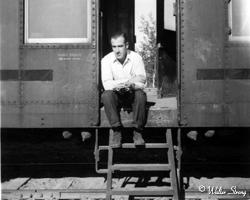 |
23. Troop Sleeper probably
parked for a section gang camp. Person, unknown, is setting in the offset
door. As an economy measure, when these cars were built they moved the
doors to the left to share the upright support of the window. This saved
the steel upright required of a centered door. |
 |
24. Taken from the main line
in the Healy Yard showing the Alaska Railroad central heating plant on
the right edge. The Suntrana Spur is out of operation as right in the middle
of the photo you can see on span of the bridge over the Nenana River is
down. |
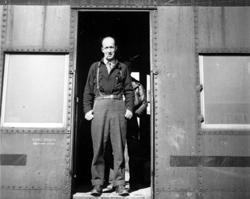 |
25. Unknown |
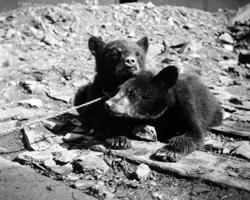 |
26. Unknown bear cubs. Maybe
Moe and Curly? |
 |
27. Yes, Martha, it is a
sun kink in Alaska. The round rock used for ballast just does not hold
the ties. Like laying a railroad on roller bearings. |
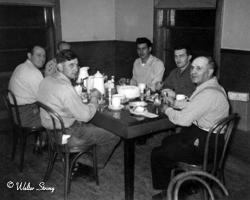 |
28. Doing what railroaders
do best. Maybe the interior of the Healy RR Hotel judging from the windows
and wall treatments. |
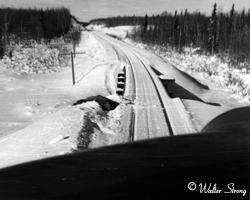 |
29. Possibly Wasilla Creek
bridge with Fairview Road in the distance? |
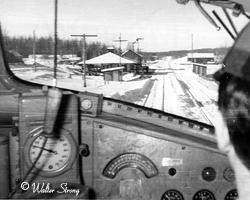 |
30. Arriving in Downtown
Wasilla about March 1953. Depot is on the left and Alaska Road Commission
warehouse is on the right where today the four lane Parks Highway is located.
Knik road crossing is just beyond the station. This was pretty much the
end of the highway and points beyond were served by the Railroad. |





























